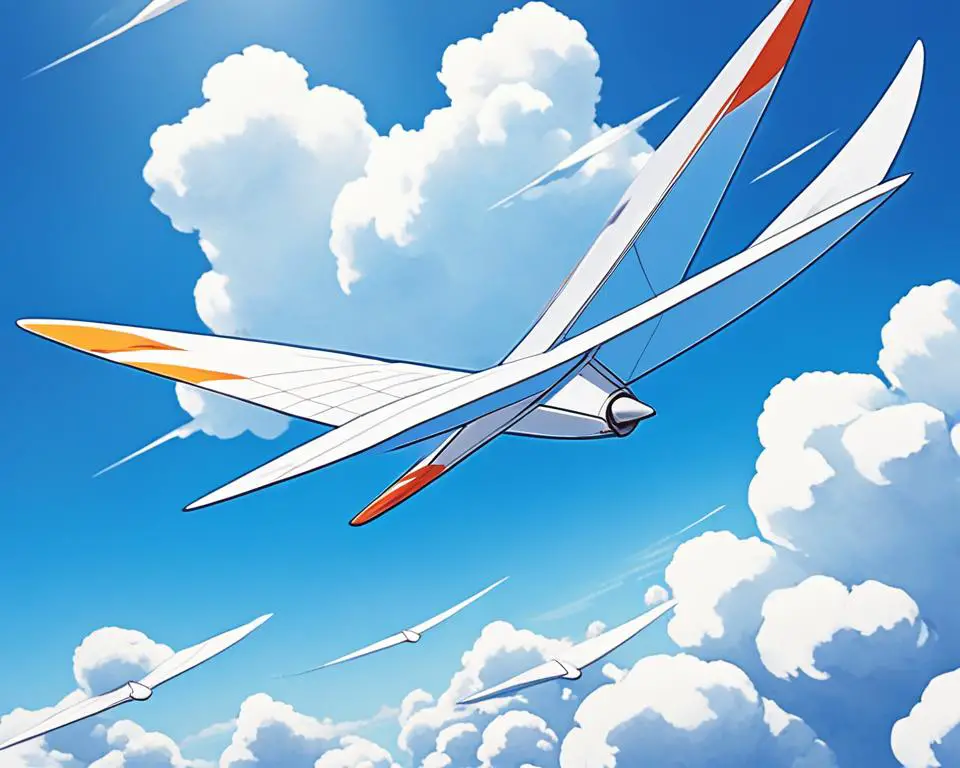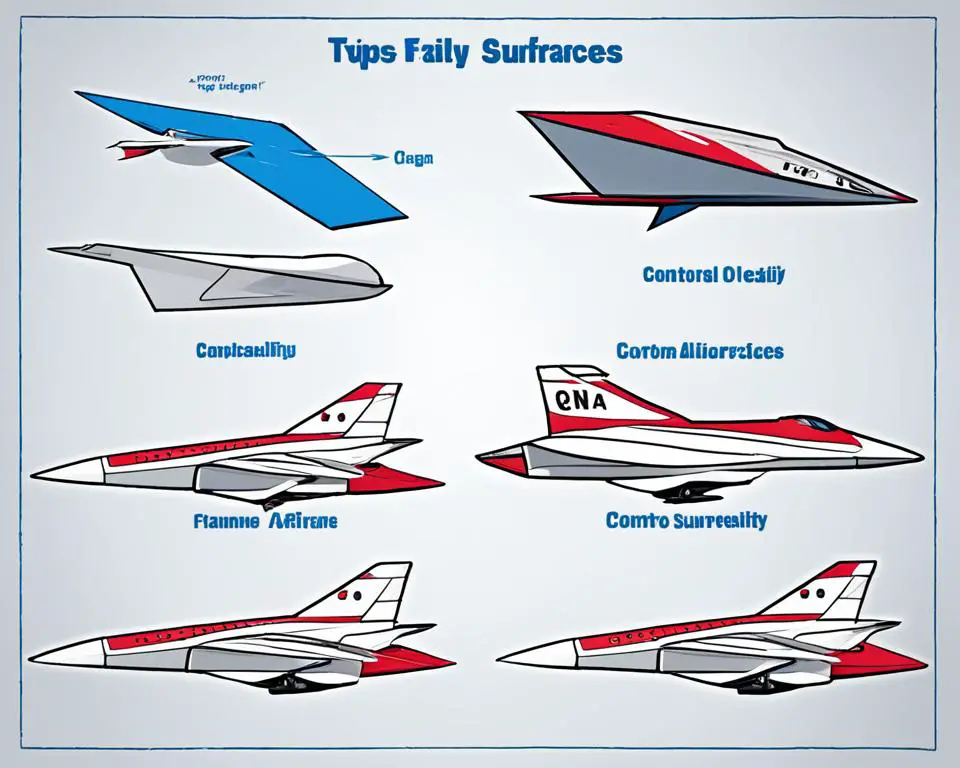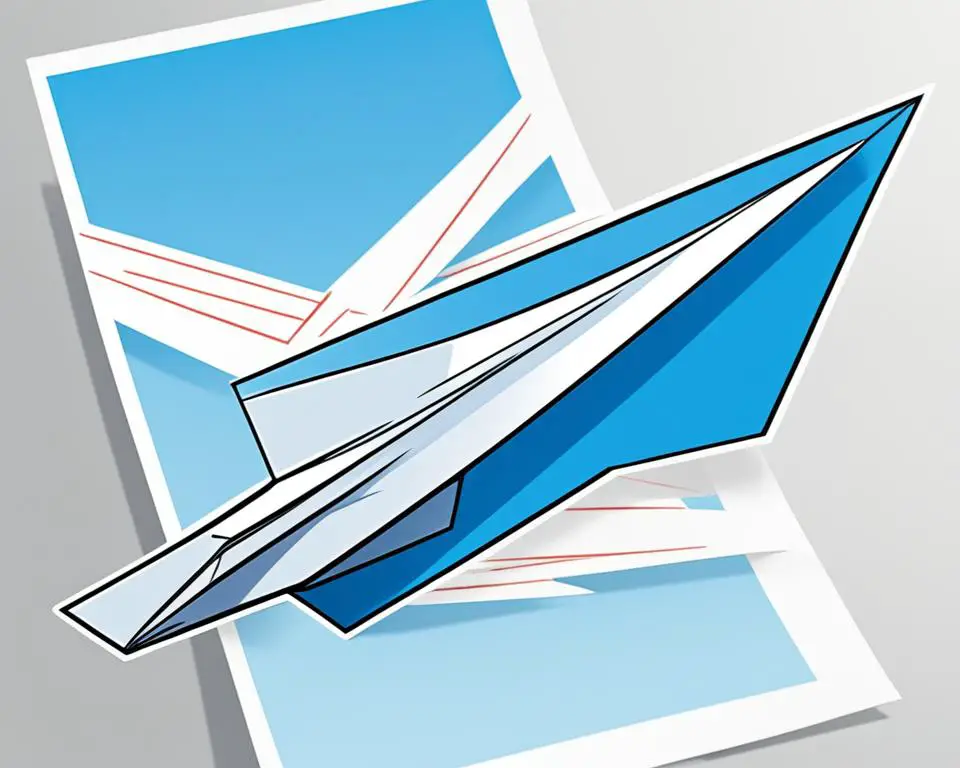Have you ever wondered what the secret is to launching a paper airplane that soars through the air with precision? Is there a specific angle that guarantees the best flight performance? Let’s explore the fascinating world of paper airplane aerodynamics and discover the optimal launch angle for achieving impressive flights.
Key Takeaways:
- The shape of the wing, the angle of attack, and the wing loading directly impact a paper airplane’s flight performance.
- An optimal launch angle can improve the glide efficiency and stability of a paper airplane.
- The main wing supports the plane during flight, and its shape influences the lift and drag forces.
- The angle of attack affects the lift and drag forces, and a slight wing camber can enhance the lift/drag ratio.
- The aspect ratio and wing loading also play vital roles in determining the glide ratio and stability of the paper airplane.
Now, prepare to unlock the secrets of launching the perfect paper airplane and witness its incredible flight performance at the ideal angle. Get ready to soar!
Key Factors in Paper Airplane Flight

When it comes to paper airplanes, understanding the key factors that contribute to their flight characteristics is essential. These factors play a crucial role in determining the glider’s stability, wing shape, and overall performance. Let’s take a closer look at the key elements that influence paper airplane flight:
Wing Shape and Stability
The wing shape of a paper airplane is crucial for creating stability during flight. A well-designed wing shape with a high lift/drag ratio is essential for a stable glider. The lift/drag ratio determines how efficiently the wing generates lift while minimizing drag. A higher lift/drag ratio ensures better stability, allowing the paper airplane to glide smoothly through the air.
Aspect Ratio and Lift Efficiency
The aspect ratio of the wing, which is the ratio of the wing span to the chord length, plays a significant role in lift generation and drag production. A high aspect ratio, achieved through a slender wing design, improves the efficiency of lift generation. This enhanced lift efficiency contributes to better gliding performance and longer flight duration.
Angle of Attack and Lift-Drag Forces
The angle of attack refers to the angle between the chord line of the wing and the direction of the airflow. It can be adjusted by changing the nose position of the paper airplane. The angle of attack directly affects the lift and drag forces acting on the aircraft. By finding the optimal angle of attack, you can achieve the right balance between lift and drag, maximizing the glider’s flight performance.
Wing Loading and Glide Characteristics
Wing loading, calculated as the weight of the paper airplane divided by the surface area of the main wing, influences the glide speed and rate of descent. A lower wing load is preferred for longer flight duration, as it allows the aircraft to stay airborne for a more extended period. By optimizing the wing loading, you can enhance the paper airplane’s glide characteristics.
Weight Distribution and Center of Mass
Aside from the wing-related factors, weight distribution and the center of mass also play a crucial role in the stability and level flight of a paper airplane. Properly balancing the weight distribution and ensuring that the center of mass is correctly positioned contributes to a more stable and controlled flight.
As you can see, several key factors come into play when determining the flight characteristics of a paper airplane. By considering the glider’s stability, wing shape, aspect ratio, angle of attack, and wing loading, you can optimize your paper airplane design for improved flight performance. Experimenting with different combinations of these factors will help you achieve the desired flight duration, efficiency, and stability.
The Role of Control Surfaces in Steerability

Control surfaces on a paper airplane, such as the rudder, ailerons, and elevator, allow for steerability and control during flight.
The rudder, a vertical control surface at the rear of the plane, is used to control the yaw or rotation around the vertical axis.
Ailerons, flaps on the wings, are used to control the roll or rotation around the longitudinal axis.
Elevators, horizontal flaps on the tail, control the pitch or rotation around the lateral axis.
By adjusting these control surfaces, the paper airplane can be steered in different directions.
However, the effectiveness of rudders on paper airplanes is limited, and ailerons play a more significant role in maneuverability.
The size and shape of these control surfaces can impact the stability and performance of the paper airplane.
Conclusion
Designing and launching a paper airplane requires careful consideration of various factors to optimize its flight performance. The shape of the wing, the angle of attack, and the wing loading all contribute to the lift and drag forces, ultimately determining the gliding ability and stability of the paper airplane. By experimenting with different angles, wing shapes, and control surface adjustments, you can enhance the flight performance of your paper airplane.
Control surfaces, including rudders, ailerons, and elevators, play a crucial role in the steerability and maneuverability of the paper airplane. By manipulating these control surfaces during flight, you have the ability to control the yaw, roll, and pitch of the aircraft. Understanding how these control surfaces function and their impact on the flight dynamics can greatly enhance your ability to control and maneuver your paper airplane.
Whether you’re aiming for longer flight duration, acrobatic maneuvers, or maximum distance, a solid understanding of the key principles of aerodynamics and control surfaces can help you achieve your goals. By fine-tuning the optimal launch angle, wing design, and control surface adjustments, you can maximize the performance of your paper airplane and achieve impressive results in terms of flight duration, maneuverability, and distance traveled. So go ahead, explore the fascinating world of paper airplane design and launch your way to paper aviation excellence!
FAQ
Q: What is the optimal angle for launching a paper airplane?
A: The optimal angle for launching a paper airplane depends on several factors, including the shape of the wing, the angle of attack, and the wing loading. The precise angle can greatly influence the flight performance of the paper airplane, so it is important to experiment and find the angle that works best for your design.
Q: How do wing shape and aspect ratio affect the flight of a paper airplane?
A: The wing shape and aspect ratio play a crucial role in the flight performance of a paper airplane. A good wing shape with a high lift/drag ratio is essential for stability and gliding ability. A higher aspect ratio, achieved by having a slender wing, can improve the lift efficiency of the airplane.
Q: What is the role of control surfaces in the steerability of a paper airplane?
A: Control surfaces, such as the rudder, ailerons, and elevator, allow for steerability and control during flight. The rudder controls the rotation around the vertical axis, while the ailerons control the roll around the longitudinal axis, and the elevator controls the pitch around the lateral axis. Adjusting these control surfaces can help steer the paper airplane in different directions.
Q: How can I optimize the flight performance of my paper airplane?
A: To optimize the flight performance of your paper airplane, you can experiment with different angles, wing shapes, and control surface adjustments. By considering factors such as the optimal launch angle, wing shape, and control surface design, you can improve the stability, maneuverability, and overall flight duration of your paper airplane.
